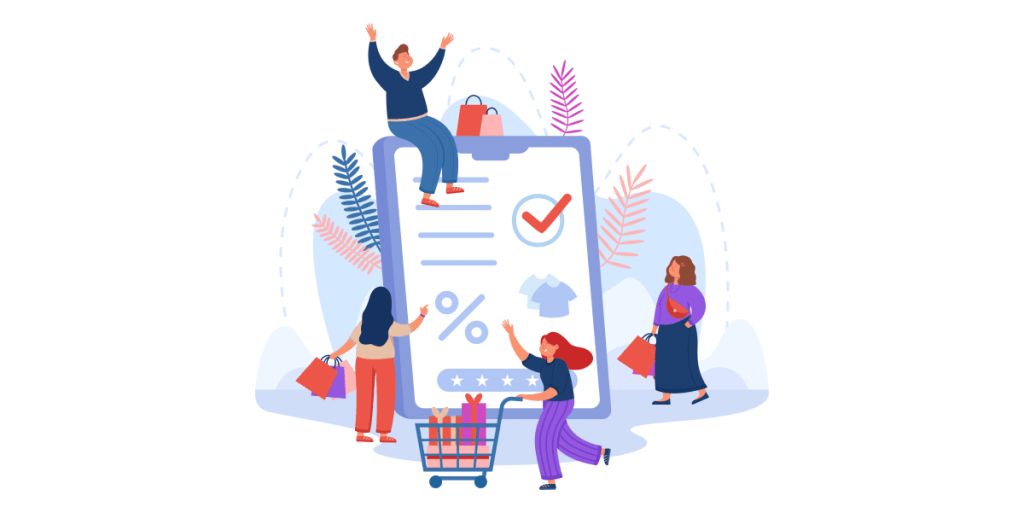Why Does eCommerce Personalization Matter So Much To User Experience?
To be successful in today’s market, you must snatch the online customers’ attention, keep them engaged and make them come back over and over again. One of the most powerful ways to do this is eCommerce personalization. The key is to be consistent with the cross-channel experience tailored to the user’s needs and goals. With big companies such as Spotify, Netflix and Amazon that adapt their personalization in real-time, customers expect the same level of personalization from all companies, no matter their size.
In this article, we will talk about the importance of eCommerce personalization, what personalization means to user experience, and we will give you some advice on how to start building or adapting your personalization to increase brand trust, boost sales and create customer loyalty. Follow along for valuable information that will help you with personalization efforts and keep you safe from being left behind.
What Is eCommerce Personalization?

eCommerce personalization makes tailored customer interactions available for online shoppers through dynamic content delivery, product recommendations, and special offers based on customer data such as previous actions on the website, demographics, purchase history, browsing behaviour, etc.
A personalized shopping experience is essential for increasing customer satisfaction and converting your target audience into loyal customers, increasing the number of repeated purchases, and increasing conversions.
You can spice up the customer journey with several types of personalization such as personalized product recommendations, email marketing activities for cart abandonment, feedback requests, promotional offers, etc.
Imagine that you are in a makeup store, and a customer needs a foundation. One of the employees will help that customer pick the foundation type and colour that best fits the customer’s needs. Just by helping or giving advice to your customers, you offer a personalized experience. Internet users expect a form of personalization when they navigate through your eCommerce website.
eCommerce personalization aims to deliver a unique and engaging user experience to increase sales.
Why Is Personalization Important in eCommerce?

Let’s explore some statistics regarding the importance of eCommerce personalization for users. We start with the fact that 74% of users become frustrated when the content is not relevant to their needs. More than that, 91% of consumers are more likely to buy from brands and shops that provide personalized offers and personalized recommendations relevant to them. 85% of consumers are influenced to fulfil a purchase if the homepage offers personalized promotions. People love to shop online and they are so eager to engage with businesses that pay attention to their needs.
Now let’s see what effective personalization means for your business. First, you improve your conversion rates and return of investment. Companies that use advanced eCommerce personalization strategies report a 20 dollars return for every dollar spent and a boost in revenue up to 15%. The chance of a millennial to become a loyal customer increases by 28% when they receive personalized communications.
Why Does eCommerce Personalization Matter So Much To User Experience?

The benefits of personalization will help you achieve your business goal and keep your customers happy. In the digital commerce era, you can personalize every step of the sales funnel. eCommerce sites must act fast as personalization drives impulse purchases. 49% of customers have purchased a product they initially didn’t intend to buy after receiving personalized recommendations from a brand.
First and foremost, personalized content will create a positive customer experience, and doing so will increase the likelihood of your visitors coming back. More than that, you can build long term relationships with your customers. eCommerce businesses can provide a unique experience to every user through targeted ads, personalized emails, relevant offers, etc. This will build a stronger relationship with your customers. A personalized online experience means that users find distinct content that captivates their attention because it seems to accommodate their needs. Our advice is to have a customer-centric approach because one customer’s online shopping experience can differ from another’s. This will benefit your business because 75% of consumers acknowledge and enjoy it when companies personalize their messages and offers for them.
Personalization grabs user attention. We, as people, have selective attention and enjoy being entertained and engaged. We usually shift our attention and focus very fast, only to things we are invested in and consider valuable. Selective attention is a great asset of the eCommerce experience, and this can be translated into personalization through relevant content, recovery cart emails, targeted ads of your popular products, etc. You can take advantage of any type of marketing strategy that can captivate the selective attention of a potential customer.
By personalizing your content, you automatically avoid information overload. In a competitive market such as eCommerce, online users are overwhelmed with hundreds of products that they are not interested in. As we mentioned before, a large percentage of users (74%) become frustrated when the content they are looking for is not aligned with their interests. Implementing a personalization strategy will ensure that users can process the information fast. When they come in contact with content or products that capture their interest, instead of feeling overwhelmed, they are thrilled.
With personalization, your customers will be in control. Through a personalized online shopping experience, your customers will feel in control of their own buying decision. They will be exposed only to products they are interested in and not be spammed with unwanted items. The feeling of being in control of a purchasing decision can be a positive factor that will lead to repeated purchases.
How to Start With eCommerce Personalization?

What is essential for marketers to understand is that the concept of the average customer does not exist. Your audience is diverse, and designing a personalization strategy for each individual is impossible. The way professionals adapt to the practice of maximizing sales is by creating digital experiences for an ideal buyer in the hope that this approach will resonate with as many users as possible.
If you want to start your eCommerce personalization, we have some advice on how to do it:
1. Collect Data About Your Customer Base
Data collection is the foundation of personalization. In this step, you can document every stage in your customer’s journey, from the first interaction with your business to purchase history and customer retention. Start by collecting data about traffic sources, on-site interactions, marketing emails responsiveness, personal data, previous purchases, price sensibility. But before you start collecting data, it is crucial to understand why you are tracking the above factors, who is the person you are tracking, when you track data – is it a period of time or in real-time, and how are you following the data – what tools and platforms are you using?
Artificial intelligence and machine learning platforms drive the best on-site real-time tracking personalization and customer data gathering. This way, they can deliver a rich, personalized experience to individual customers.
2. Draft a Personalized Strategy Around Your Business Size and Needs
While drafting your first personalization, we recommend taking into consideration the size of your customer base, the volume of sales generated, and the personalization tools you are going to use.
Here are some eCommerce personalization examples that you can take advantage of: all-in-one personalization platforms, checkout page, email, on-site product recommendations, search queries, paid ads, personal data, feedback, pricing, push notifications and traffic. You should answer the following questions for each of these elements: What are your data segments? What can you personalize? What tools are you going to use? What is the business size?
3. Audience Segments and Customer Profiling
Audience segmentation is a method that allows us to group our customers based on insights about them such as location, income, behaviour, purchase journey, etc. Segmentation will identify a few key points about similar traits of a customer group. Our opinion is that segmentation is not enough, and you should go for creating customer profiles, as they will give a more holistic overview. If you don’t know what to include in a customer profile, follow our guide on how to create a customer profile step-by-step.
4. Create On-Site Offers Based on User Behaviour
The easiest way of creating a personalized digital experience is to create offers based on how users interact with your website. To maximize your results, you should know how your audience shops on your website.. Several key factors to consider are your most popular posts and pages, your high-converting posts and pages, your customer purchase or browsing history, search queries on your website, etc. Our advice is to let the user behaviour trigger the offers and products you will show them.
5. Create Offers Based on Customer’s Geolocation
Another form of personalization is to customize your massage based on the physical location of your customers. If you also have a brick-and-mortar store, this can also help you increase the traction in your physical shop. More than that, the geolocation targeting will help you increase the attendance at regional events, improve seasonal campaigns online and offline, etc.
6. Use Marketing Techniques to Increase the Average Order Value
The three methods to increase average order value (AOV) at checkout are up-sell, cross-sell and down-sell techniques. The upsell technique suggests products that are more expensive than the products in your user’s shopping cart. The cross-sell technique suggests to your user’s items similar to what they have been browsing or purchased in the past, and the price of the recommended products is not important for this approach. The down-sell technique suggests less expensive products than what your users have purchased before or have in their carts. These three techniques are most effective right before the checkout process, during the checkout process, or immediately after the purchase.
7. Send Email Campaigns Based on Customer’s Journey
eCommerce is different because personalization brings more revenue or boosts the store’s income after the user has left your website. A great way to do this is to implement various email marketing campaigns. An essential aspect is to collect your customer’s email address. This can be done through opt-in forms. The opt-in forms can be pop-ups, floating bars, welcome mats, etc. You can offer a discount if your customers decide to opt-in, which will better convince them to do it. You can create an email list for new subscribers and smoothly guide them through your sales funnel. Another email marketing campaign can be set up for shopping cart abandonment.
8. Retargeting
When users are engaged with your website, you can set up retargeting campaigns to encourage them to return to your website. You will personalize the ads your users are going to see to complete a purchase or make another one. You can set up your retargeting campaigns with Google AdWords, Retargeter, AdRoll or Facebook.
Customers love personalization, but the secret to great personalization is to be relevant and subtle. For your businesses success, no matter the size or industry, you should have a strong alignment with your customer’s needs. The right mindset for success is how much I can help my customers overcome their problems with my products or services. When you focus inwards on your company and how much you can sell, the return of investment might not be what you expected.
Our Expertise

The eCommerce industry is one of the most competitive markets. Catching users’ attention is key to business success. Our advice is to start by A/B testing, segmenting, optimizing and targeting your audience. You should consider incorporating artificial intelligence and machine learning into your strategies, as these two can drive a tremendous benefit in improving eCommerce personalization.
We start every project with thorough research on the customer base and competition. More than that, we want to understand the products or services and business needs and goals. Based on the findings, we will implement, test, gather results and optimize our approach to deliver the best results for our partners while keeping their customers happy. Check out our fashion eCommerce case study to learn more about how we worked on the project, what marketing actions we implemented, and the results we got. You can also look at our portfolio, check out our reviews and contact us today.
Let’s start working together towards getting the results you want!
Frequently Asked Questions
Sales, customer engagement, customer loyalty and customer retention.
Yes. The more personalized the content, campaigns and ads, the more relevant it becomes for your customers.
Yes! 72% of consumers say they only engage with personalized messaging.